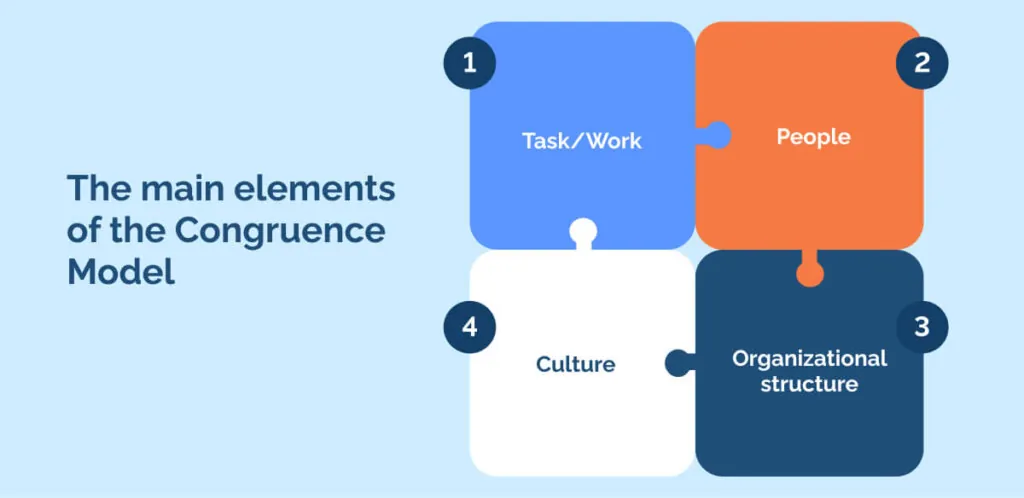
The first essential step in designing and executing an organization’s successful change strategy is understanding its structure and functioning better. Leaders need a detailed plan to pinpoint and tackle performance challenges within a multifaceted organization.
The Nadler-Tushman Congruence Model is an effective diagnostic tool for organizations to identify and rectify discrepancies among four critical aspects: work, people, structure, and culture.
This model operates on the principle that an organization’s success hinges on the alignment or congruence of these elements. When they are well-aligned, the likelihood of organizational success increases.
Conversely, a lack of congruence, or a mismatch among these elements, can cause various issues, including reduced productivity, high employee turnover, and customer dissatisfaction.
By the end of this guide, you will understand:
- What the Congruence Model is and its four main elements
- The benefits and disadvantages of the Congruence Model
- A step-by-step guide to applying the Congruence Model within your business
What is the Congruence Model?
The Congruence Model, created by David A. Nadler and Michael L. Tushman in the early 1980s, is a significant framework in organizational design. It serves as an instrumental method for pinpointing the fundamental reasons behind organizational performance issues and suggests approaches for resolving them.
This model is grounded in the belief that the success of a team or an organization is contingent upon the harmonious alignment of four critical elements: the work itself, the people performing it, the organizational structure, and the prevailing culture. These elements must be in sync or ‘congruent’ for optimal functioning.
When there’s a mismatch or ‘incongruence’ among these elements, it often leads to problems within the organization.
What are the main elements of the Congruence Model?

To address underperformance, management must first pinpoint key performance drivers. The Nadler-Tushman Congruence Model categorizes these into four essential areas:
Task/Work
This element involves the work carried out by employees. Questions to consider are the nature of tasks or processes, steps to optimize task efficiency and effectiveness, and the meaningfulness of the work. You should also consider any challenges that make work less fulfilling.
People
This pertains to whether employees have the necessary skills and knowledge. Considerations include the types of personalities typically hired, compensation adequacy, and applying this scrutiny across all levels, from upper management to frontline workers.
Organizational structure
This includes standardized policies, processes, procedures, and systems. Factors like levels of management, decision-making delegation, the physical setup of business units, and their geographical distribution are vital aspects.
Culture
The most complex to define is that culture encompasses tangible (values, vision, change leadership style) and intangible aspects (employee-management trust, support for decision-makers, ethical management practices).
Why is the Congruence Model focused on four elements?
The Congruence Model focuses on the principle that success for any organization, business, or team hinges on the fit or congruence among these four elements: work, people, structure, and culture. This aligns with open systems theory.
The greater the congruence among these elements, the better an organization performs and the quicker it reaches its goals. Incongruence leads to problems and poor performance.
The main goal of this model lies in its ability to analyze how these four elements interact, impacting the organization’s overall performance. For example, an organization with talented employees may underperform if the cultural dimensions don’t suit their working style.
Similarly, you could underutilize advanced technology in a setting burdened by bureaucratic processes and unsuitable organizational structures. The model aids businesses in identifying such issues and necessitates changes to rectify them.
In today’s competitive business environment, understanding the impact of changes across these elements is crucial. The Congruence Model equips leaders to consider how alterations in one area might affect others, ensuring more holistic and effective organizational management.
Benefits of the Congruence Model
The Congruence Model is a conceptual framework similar to McKinsey’s 7-S Model, aimed at providing a comprehensive view of the various elements within an organization that impact change. It’s simpler to define its components compared to the McKinsey model.
However, its vital distinction lies in incorporating a concept from Systems Theory: the feedback mechanism from the organization in response to external stimuli.
In contrast, McKinsey’s model is generally more static, focusing on identifying the current and potentially future state.
The Congruence Model, on the other hand, emphasizes the dynamic effects of the model on proactive change management initiatives, making it particularly useful throughout the change process.
Disadvantages of the Congruence Model
While the Nadler-Tushman Congruence Model is a valuable tool for identifying performance-related issues in organizations and teams, it has some notable limitations.
Primarily, the model excels at highlighting problems that may be impacting performance negatively, but it stops short of offering specific solutions or guidance on resolving these issues.
The model doesn’t recommend particular organizational structures or cultural frameworks that might be most effective for a given organization. It also needs to provide action plans for addressing the identified problems. As a result, organizations might need to turn to additional tools for solutions.
For instance, if there’s a mismatch between the work and the people doing it, models like the B.A.L.M. task allocation model could address this incongruence. Similarly, if there’s a disconnect between the work and the organizational structure, tools focusing on organizational design might be necessary.
Another critical limitation of the Nadler-Tushman Congruence Model is its focus solely on internal factors affecting performance. It does not consider external factors that could influence organizational performance, either positively or negatively.
To get a comprehensive view of all factors affecting an organization’s performance, including external ones, you may need to use tools like PMESII-PT and PEST Analysis alongside the Nadler-Tushman model.
These tools can help analyze external political, economic, social, technological, environmental, and legal factors that the Nadler-Tushman model does not cover.
Step-by-step guide to applying the Congruence Model within your organization

The four elements of the Congruence Model interrelate closely, and the greater their alignment, the better the organization’s performance. Thus, the model highlights the importance of simultaneously focusing on all four elements, as this comprehensive approach is vital to the success of any change initiative.
With this in mind, implementing the Congruence Model involves a three-step process:
- Conduct an audit of each component on its own
First, you need to assess the state of each of the four key components and how they appear currently at your organization. In terms of the task or work element, evaluate the core tasks critical to your organization’s performance from two angles – the nature of the work and its process flow.
Assess the required skills or knowledge for each task, determining if they are routine or innovative, and observe how work progresses. If done well, you must also understand the pressures and incentives for a particular task.
Next, when considering the people element of the model, examine the employees responsible for carrying out tasks, assessing their skills, experience, education, compensation preferences, organizational commitment, and career aspirations.
Then, evaluate your current organizational structure, systems, and processes. Look at its hierarchical structure, business units, reporting lines, policies, procedures, and remuneration. This evaluation will also help you assess the capability for organizational development.
Lastly, you can analyze the current culture at your organization by investigating its leadership styles, beliefs, and values. It is also essential to assess any undocumented processes or rules that state how work is to be done and how important messages are communicated to staff, i.e., is it through leadership giving regular updates or just a standard email from the HR department?
- Consider how well the four elements interact with each other
Secondly, assess how each of the four elements relate to each other to identify areas of congruence and incongruence. You should have six main pairs to assess:
- work/task and people
- work/task and structure
- structure and people
- people and structure
- culture and work
- structure and culture
In terms of work and people, you will need to assess whether the work currently being performed is suitable for employees and whether they understand how their day-to-day responsibilities fit into the broader business strategy.
Suppose there is incongruence between these two elements. In that case, you should assess whether your organization needs better individuals or upskill or reskill employees to ensure the work is suitable. A skills matrix could help assess skill gaps and determine employees’ skill levels.
Next, a lack of unity between work and structure might indicate a lack of processes to enable work to be done efficiently. Similarly, there might be a weak link between structure and people if the current organizational structure results in siloes rather than collaboration.
Alternatively, if employees respond well to the current leadership style and show little resistance to change, this could indicate a strong link between the elements of people and culture. Following this, if work is consistently done in line with the beliefs and values of the company, it could highlight a stronger correlation between culture and work.
Lastly, if your organization has a flat organizational structure with cross-functional teams, this structure is more conducive to a collaborative environment. So, in this way, the culture and structure complement each other rather than conflict.
- Use the responses from step 2 to build congruence
The main takeaway of the Congruence Model is that an organization can perform well only if all four elements are aligned or congruent.
At this final stage, you must decide which changes are necessary to allow all four areas to work well together. It is essential to understand that one change to a pair of elements could adversely affect another pair. Therefore, each weak link must be looked at in detail and only changed if necessary.
Unfortunately, the Nadler-Tushman Congruence Model does not offer guidance on how to solve any issues with congruency. This means that leadership will need to choose one of the other change management models to diagnose and resolve the issue.
Key takeaways in relation to the Congruence Model
The Nadler-Tushman Congruence Model posits that high performance in businesses and organizations is achievable when there is congruence among four critical elements: work, people, structure, and culture.
This model suggests that when these components align and function together seamlessly, similar to a well-oiled machine, the result is smooth, efficient, and effective operations, leading to enhanced overall performance within the organization.
Conversely, a lack of compatibility among these elements can lead to friction, hindering the organization from reaching its full performance potential.
The Nadler-Tushman Congruence Model is one of the change management tools for organizations to assess the compatibility or congruence between these elements, enabling them to discover and assess the root causes of performance-related issues.
Organizations can develop strategies to resolve these issues by pinpointing them, boosting their overall performance.However, while the Congruence Model is an effective diagnostic tool for identifying problems, it does not offer comprehensive guidance on executing a change process. This limitation means that organizations may need to incorporate additional tools to support the change management process.
WalkMe Team
WalkMe spearheaded the Digital Adoption Platform (DAP) for associations to use the maximum capacity of their advanced resources. Utilizing man-made consciousness, AI, and context-oriented direction, WalkMe adds a powerful UI layer to raise the computerized proficiency, everything being equal.



